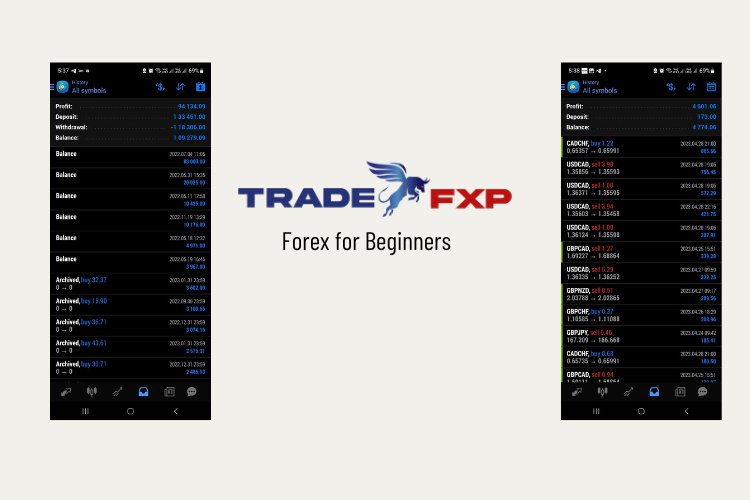Mastering Forex for Beginners: Essential Tips and Strategies
Start forex trading with TradeFXP's Forex for Beginners guide. Uncover forex basics and turn a novice into an expert. Ignite your forex journey today!

Forex for Beginners
· Introduction to Forex Trading
· How Forex Trading Works
· Profiting from Exchange Rate Changes
· Trading Currency Online with Brokers
· Benefits of Trading Forex with TradeFxP
Introduction to Forex Trading
In this section, the speaker introduces the concept of forex trading and its relevance to individuals who have travelled to foreign countries. Forex trading involves exchanging currencies when traveling or for business purposes. Companies also participate in forex trading when they need to obtain local currency for purchasing goods from other countries.
How Forex Trading Works
When companies exchange large amounts of currency, it affects the demand and price of that currency. Exchange rates constantly fluctuate based on supply and demand in the market.
Profiting from Exchange Rate Changes
If you change your money at a favourable exchange rate and hold onto it while the rate changes, you can make a profit when exchanging it back. This is similar to how traders in the forex market buy a certain amount of currency, hold onto it, and then sell it back at a higher rate.
Trading Currency Online with Brokers
Online brokers allow individuals to trade currencies throughout the day and take advantage of fluctuating exchange rates. Trading forex online has several benefits, including convenience, accessibility, and lower starting budgets compared to traditional methods.
Benefits of Trading Forex with TradeFxP
Trading forex can be done from anywhere with an internet connection. The forex market is open 24 hours a day, five days a week, allowing flexibility in trading. Starting with as little as $150, individuals can begin trading and build their accounts over time.
Achieving Financial Freedom
The purpose of trading is to gain financial freedom and have the power of choice in life. Swing or day trading in the Foreign Exchange Market (Forex) allows individuals to live the life they desire. Trading does not require large amounts of money or spending all day in front of a computer. Only one hour or 35 minutes per day is needed for trading activities. All that is required is access to a phone or computer.
Understanding Forex Basics
Forex stands for foreign exchange. It involves buying or selling currencies rather than owning tangible assets like in the stock market. Forex trading offers more benefits compared to stock trading, such as lower fees and flexible trading hours. The Forex market moves 6.3 trillion dollars daily, providing ample opportunities for profit. Currency pairs, such as EUR/USD or USD/JPY, represent the relationship between two currencies. Traders bet on whether one currency will strengthen or weaken against another.
Trading Opportunities and Market Timing
The market is open 24/5, but the New York session and London session are the most active. Avoid trading at the beginning or close of the market due to high spreads.
Trading Currency Pairs
The most traded pair is EUR/USD because the dollar and euro are common currencies with high volume. Trading EUR/USD is cheaper compared to other currency pairs with lower volume.
Making Money from Trading
You can make money in both bullish (market going up) and bearish (market going down) markets. Profit can be made by buying with an upward trend or selling with a downward trend.
Long, Short, Bullish, Bearish
"Long" means buying a currency pair, indicating a bullish outlook.
"Short" means selling a currency pair, indicating a bearish outlook.
Bid Ask Spread
The bid ask spread is the difference between the price at which dealers sell and buy currencies. Brokers may mark up spreads, leading to higher costs for traders.
Choosing a Broker with Tight Spreads
Selecting a forex trading broker with tight spreads can save money on trading fees. The recommended broker in the video has competitive spreads.
Fundamental Analysis
Fundamental analysis involves using news and other factors to inform trading decisions. The speaker personally focuses on technical analysis and finds fundamentals unnecessary.
Forex Charts and Candlesticks
Forex charts use candlesticks to represent price action. Japanese candlestick charts are commonly used.
Understanding Candlesticks
Candlesticks are a key tool for understanding charts in forex trading. They provide a visual representation of price movements. Candlestick charts are explained in a 60-page document linked in the video description. The document uses pictures to explain how to read candlesticks and understand the flow of the chart.
What is a Pip?
A pip is a unit used to calculate stop loss and take profit levels in forex trading. Pip stands for "point in percentage" and represents the smallest possible price change. Pips are used to calculate the points within currency pairs, such as USD/GBP or USD/JPY. Brokers use pips to determine spreads when buying or selling currency pairs.
Understanding Lot Size
Lot size refers to the amount of risk per trade in forex trading. Lot size determines how much you will make or lose on a trade. Higher lot sizes increase potential profits but also increase potential losses. Position size calculators can help determine the appropriate lot size based on risk tolerance and account size.
Importance of Leverage
Leverage allows traders to borrow money from brokers or investors to trade larger lot sizes. Using leverage can be risky if not managed properly. Different brokers offer varying leverage options, ranging from 1:50 to 1:1000. It is recommended not to exceed 1:100 leverage unless necessary, as higher leverage increases the risk of blowing your account.
Understanding Margin
Margin refers to trading with borrowed money, which can increase potential returns but also risks. The amount of margin is usually a percentage of the position size. Margin allows traders to trade larger positions than their account balance would allow. It is important to be cautious with margin usage to avoid margin calls and potential losses.
How Brokers Facilitate Trades
In this section, the speaker explains how brokers facilitate trades and make money on the spread. Brokers connect traders to the markets by taking their trade orders and connecting them to the market. When a trader wants to buy or sell a currency, the broker takes their money and connects it to the market. When a trader decides to withdraw their funds, the broker retrieves the money from banks and returns it to the trader. Brokers earn money through spreads, which is the difference between buying and selling prices.
Benefits of Using a Broker
The speaker discusses why using a broker is beneficial for traders compared to dealing with banks directly. Brokers save traders from dealing with banks one-on-one and paying high fees. It is not possible for traders to go directly to a bank; they have to use brokers as intermediaries. Brokers provide instant access to markets and offer competitive prices.
Essential Platforms for Trading
The speaker introduces two essential platforms for trading - TradeFxP and MetaTrader (MT4/MT5). TradeFxP is used for market analysis, charting, and markup of currency pairs. MetaTrader (MT4/MT5) is used for executing trades based on analysis done on TradeFxP. Traders can download MT4/MT5 from app stores or directly from our websites.
The Importance of Psychology in Trading
The speaker emphasizes the significance of psychology in trading and how it is often overlooked by beginner traders. Psychology plays a crucial role in trading success. Many beginner traders realize after one year that they need to work on their psychology rather than technical analysis. Emotions, such as fear of missing out (FOMO) and greed, can impact trading decisions. Developing the proper mindset is essential for successful trading.
Long-Term Approach in Trading
Traders should focus on long-term profitability rather than quick gains. Analyzing multiple time frames, such as weekly, daily, and four-hour, helps identify favourable trading opportunities.
Identifying Areas of Interest
Areas of interest are zones with at least three touches that indicate potential buying or selling zones. In a bullish scenario, traders look for areas of interest to buy.
Validating Trades with Multiple Time Frames
When taking a trade, it is important to consider the alignment of multiple time frames. Being above an area of interest on multiple time frames indicates a higher probability of an upward move.
Applying the Strategy and Profit Calculation
The speaker explains how they applied the strategy discussed earlier and achieved a profitable trade. They mention that this particular trade resulted in a profit of approximately 2.5%.
Conclusion
Forex trading involves exchanging currencies based on supply and demand in the market. By understanding how exchange rates fluctuate, individuals can profit from favourable rate changes.
Please join us for more information and to know how to make profits in Forex market without the troubles of trading by yourself. CLICK HERE to join.
To read why you should be with us, click here
To open an account, click here.
To see our regulation certificate: click here.
To see our news with the IFMRRC: click here.
For claims, click here.
For the main site: click here.
For blogs and articles: click here.



 admin
admin 










